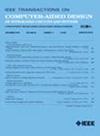A Unified Deep Reinforcement Learning Approach for Constructing Rectilinear and Octilinear Steiner Minimum Tree
IF 2.9
3区 计算机科学
Q2 COMPUTER SCIENCE, HARDWARE & ARCHITECTURE
IEEE Transactions on Computer-Aided Design of Integrated Circuits and Systems
Pub Date : 2024-12-27
DOI:10.1109/TCAD.2024.3523429
引用次数: 0
Abstract
The Steiner minimum tree (SMT) serves as an optimal connection model for multiterminal nets in very large scale integration (VLSI). Constructing both rectilinear SMT (RSMT) and octilinear SMT (OSMT) are known to be NP-hard problems. Simultaneously, constructing multiple topologies of SMTs for a given net holds significant importance in alleviating routing constraints such as alleviating congestion and ensuring timing convergence. However, existing efforts predominantly focus on designing specialized methods to construct a specifically structured SMT for a given net, making it challenging to extend to different structures or topologies of SMTs, while also exhibiting insufficient optimization capabilities. In this work, we propose a unified approach based on deep reinforcement learning (DRL) to address both RSMT and OSMT problems while generating diverse routing topologies. First, we design an edge point sequence (EPS) that leverages the structural characteristics of SMT to connect the output of the deep learning model with the SMT structure. Second, we propose a deep learning model tailored for EPS, employing the negative wirelength of SMT as a reward to train the model using DRL. Third, we provide a corresponding rapid and accurate wirelength computation algorithm for evaluating the quality of the construction solution to expedite model training. Finally, we leverage the stochastic nature of machine learning to construct diverse SMT construction solutions. To the best of our knowledge, this is the first unified approach capable of simultaneously addressing both RSMT and OSMT problems while generating diverse solutions. The proposed unified approach demonstrates superior solution quality and higher efficiency compared to specifically designed algorithms.一种统一的深度强化学习方法构建线性和八线性Steiner最小树
Steiner最小树(SMT)是超大规模集成电路(VLSI)中多终端网络的最优连接模型。构建直线SMT (RSMT)和八线性SMT (OSMT)都是np困难问题。同时,为给定的网络构建多个smt拓扑对于缓解路由约束(如缓解拥塞和确保定时收敛)具有重要意义。然而,现有的努力主要集中在设计专门的方法来为给定的网络构建特定结构的SMT,这使得扩展到不同结构或拓扑的SMT具有挑战性,同时也显示出不足的优化能力。在这项工作中,我们提出了一种基于深度强化学习(DRL)的统一方法,以解决RSMT和OSMT问题,同时生成不同的路由拓扑。首先,我们设计了一个边缘点序列(EPS),利用SMT的结构特征将深度学习模型的输出与SMT结构连接起来。其次,我们提出了一个针对EPS的深度学习模型,利用SMT的负波长作为奖励,使用DRL训练模型。第三,我们提供了相应的快速准确的长度计算算法,用于评估施工方案的质量,以加快模型的训练。最后,我们利用机器学习的随机特性来构建各种SMT构建解决方案。据我们所知,这是第一个能够同时解决RSMT和OSMT问题的统一方法,同时生成不同的解决方案。与专门设计的算法相比,所提出的统一方法具有更好的解质量和更高的效率。
本文章由计算机程序翻译,如有差异,请以英文原文为准。
求助全文
约1分钟内获得全文
求助全文
来源期刊
CiteScore
5.60
自引率
13.80%
发文量
500
审稿时长
7 months
期刊介绍:
The purpose of this Transactions is to publish papers of interest to individuals in the area of computer-aided design of integrated circuits and systems composed of analog, digital, mixed-signal, optical, or microwave components. The aids include methods, models, algorithms, and man-machine interfaces for system-level, physical and logical design including: planning, synthesis, partitioning, modeling, simulation, layout, verification, testing, hardware-software co-design and documentation of integrated circuit and system designs of all complexities. Design tools and techniques for evaluating and designing integrated circuits and systems for metrics such as performance, power, reliability, testability, and security are a focus.

 求助内容:
求助内容: 应助结果提醒方式:
应助结果提醒方式:


